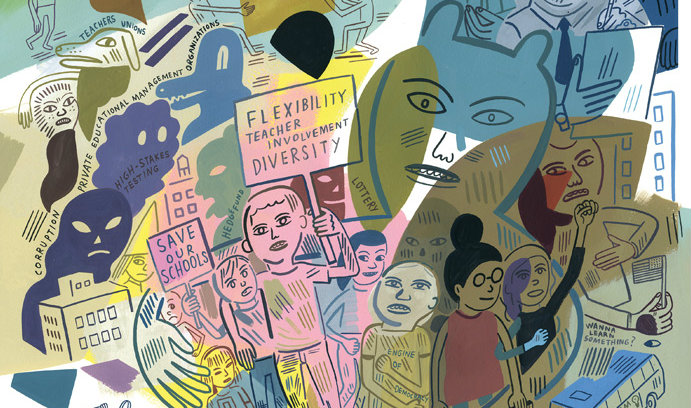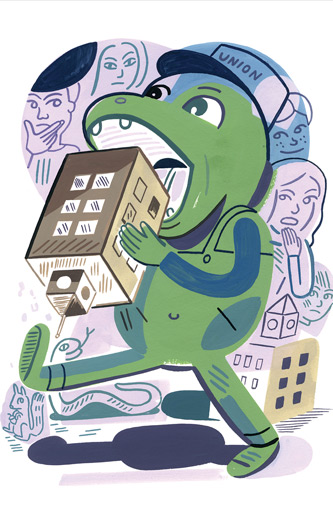The Charter Challenge

As charter schools proliferate, a polarizing debate could use common ground.
E.L. Haynes Public Charter School in Washington, D.C., won awards for its student achievement gains in 2008, 2009 and 2010 with a diverse mix of students of all races, socioeconomic levels and English language learners.
In 2009 and 2010, three Excel Academy charter schools in Miami-Dade County, Fla., were closed after just a couple of years in existence because of dismal scores on the state’s standardized tests.
Under the charter school model, both outcomes could be seen as examples of success: Good schools flourish; bad schools close.
But does that model ignore the collateral damage of students’ educations disrupted, taxpayer money misspent and neighborhood schools shortchanged? Or does it take fresh thinking to innovate in education and elevate learning for students who might otherwise be stuck in traditional public schools that are failing them?
Few topics in education evoke stronger reactions. Public school teachers unions and their allies say it’s amateur hour in the landscape of American education as charters proliferate across the country, some run with little oversight and by people with little experience as educators. The result, they say, is a more segregated school system with charters siphoning money and the best students from neighborhood schools, leaving them with more at-risk students and less money to educate them.
Charter advocates, who include wealthy philanthropists such as Bill Gates, Eli Broad and the Walton Family Foundation, argue charters are providing poor children with the kind of educational opportunities and school choice that middle-class and wealthy families have always had by virtue of where they live.
Both sides have valid points, said Gary Sasso, dean of Lehigh’s College of Education, and what’s needed are efforts to find common ground.
“You have people on both sides of this issue cherry-picking the data that support what they want to support,” Sasso said. “What we’re trying to promote as a college is that there needs to be a way that we can find common ground. That common ground might be found in research-intensive colleges of education that insist on the best objective data regarding education policy and practice.”
Sasso made comparisons to extensive drug trials in medicine, when benefits and side effects are weighed. “None of that exists in education,” he said. "There is no research-to-approval process in education.”
The irony in the charter debate is that charters were initially proposed by Albert Shanker, the longtime president of the American Federation of Teachers. He saw such schools as potential bastions of educational experimentation and innovation, whose successful methods could then be shared with traditional public schools.
Shanker envisioned charters as schools run by small groups of teachers and parents who would have five-year contracts to prove the schools’ worth.
Today, charters are publicly funded, independently operated and authorized by a state-approved entity. They have more autonomy and flexibility in areas such as staffing and curriculum than traditional public schools but administer the same state standardized tests. Unlike with traditional school districts, the public does not get to elect charter school boards. And, their finances and methods are not subject to oversight.
Since Minnesota passed the first law allowing for the establishment of charter schools in 1991, 42 other states and Washington, D.C., have followed suit. Currently, according to the National Alliance for Public Charter Schools, more than 6,700 charter schools educate more than 2.9 million students, or about 6 percent of all public school students.
The vast majority of charters—88 percent —are not unionized. The two largest teachers unions, the National Education Association and the American Federation of Teachers, and their allies suspect that wealthy hedge-fund managers and philanthropists such as the Waltons of the Walmart fortune support charters at least in part because they want to weaken one of the strongest segments of public sector unions, and therefore a large liberal voting bloc.
Meanwhile, charter advocates argue the rigidity of teachers’ contracts would stymie the flexibility their schools need to boost achievement. For example, many charters have a longer school day and school year than traditional public schools—which unions might balk at. Charters also want freedom to fire teachers without long, drawn-out struggles with unions.
So the battle lines are drawn. Yet there have emerged some education analysts who say lionizing charters or demonizing them misses the point. Matthew Di Carlo, a senior research fellow at the Albert Shanker Institute in Washington, D.C., says the question should be why do some work well and others poorly?
“At a national level, the differences between charter schools and the regular public schools to which they are compared are usually either not statistically discernible or they are quite modest,” Di Carlo said. “To me the most interesting thing is they vary a great deal between states, within states and, most importantly, by school.”
Among those that do well on state standardized tests are charters that extend the school day, he said. Other successful strategies include high doses of tutoring.
’No Excuses’ Schools
It’s generally accepted that family income and parents’ education levels are the strongest predictors of how students will do in school. Yet a few high-profile charters serving low-income populations boast of turning that truism on its head.
KIPP schools and Success Academy are among what’s been dubbed “No Excuses” schools that employ longer school days and school years to achieve better test results than regular public schools. KIPP —Knowledge is Power Program—has 183 schools around the country and Success Academy has 32 schools in New York City.
The 2014 test scores put Success Academy in the top 1 percent of all public schools in New York state in math and the highest 3 percent in English.
Both school networks work with large numbers of minorities and low-income students, though they generally have fewer students with disabilities and those who are English language learners. They are known for strict discipline, strong test-based accountability and requiring parental involvement.
Craig Hochbein, an assistant professor in Lehigh’s College of Education, said the admissions process at charters such as Success Academy makes it likely that the students who get in have involved family members and advocates. In an op-ed piece in Newsday, Hochbein suggested that if all public school students were automatically put in a lottery for a seat in a charter school when they registered for school, that advantage would disappear.
“If I think my charter school is better than the traditional public school,” Hochbein said, “and I think that it has nothing to do with who applies to my school, who I admit or any of what we call in the research world ’selection bias,’ then I want to go out and prove it to the world. Give me whoever you’ve got. Give me a group that looks just like the public school.”
Skeptics argue the charters’ high scores are attributable to intensive test prep and lower-performing students quitting KIPP and Success Academy schools. Unlike in neighborhood schools, few of those who leave are replaced by new students in the higher grades.
Sasso said charters like Success Academy and KIPP are not for every child, and they shouldn’t compare their results to those of traditional public schools that are operating with a different set of rules. The “No Excuses” regimen is stringent, but for those students who stick with it, the schools can put them on a better trajectory, he said.
Research Under Fire
There have been dozens of studies on the effectiveness of charter schools, but the largest come from Stanford University’s Center for Research on Education Outcomes (CREDO). In a 2009 study, CREDO looked at schools in 15 states and Washington, D.C., and found that 17 percent of charter schools had students who performed better than students in comparable traditional public schools, 37 percent of the charters did worse, and 46 percent showed no statistical difference.
In 2013, CREDO released a report that studied charters in 26 states and New York City and found that 25 percent had “significantly stronger learning gains in reading than their traditional school counterparts, while 56 percent showed no significant difference and 19 percent of charter schools had significantly weaker learning gains.” In math, 29 percent of charters did better, 40 percent the same and 31 percent worse.
CREDO’s latest study, “Urban Charter School Study Report on 41 Regions,” released in March, found that “urban charter schools in the aggregate provide significantly higher levels of annual growth in both math and reading compared to their [traditional public school] peers.”
The report, which looked at charters in cities in 22 states, said that gains in math and reading were especially significant for charter students who are black, Hispanic, low-income and in special education. But the results varied by region, with charters in 11 of the cities doing worse than traditional public schools in math and charters in 10 of the regions doing worse in reading.
The 2015 study has drawn fire. Working with a statistician, journalist Andrea Gabor found problems with the CREDO research model. For example, if a student dropped out of a charter school, he or she was eliminated from the study. Gabor argued that those dropping out are likely to be the weaker students whose test scores would bring down the charter school’s average.
The New Orleans Experiment
In 2005, Hurricane Katrina wiped out much of New Orleans, including its poor-performing public schools. Seeing an opportunity to start fresh, the Louisiana Department of Education fired the unionized public school teachers en masse and accelerated the Recovery School District’s transformation to 100 percent charter schools. Education reformers, charter school operators and some 400 Teach for America recruits headed to New Orleans for what was to be a great educational experiment.
So how has it worked?
By some accounts, it has succeeded dramatically. Standardized test scores for the all-charter Recovery School District have risen consistently, with the number of students scoring basic or above rising from 37 percent in 2009 to 57 percent in 2013.
But there have been complaints. In the 2007-2008 school year, expulsion rates in the Recovery School District were 10 times the national average, according to a report by the Southern Poverty Law Center. The Recovery School District has been the target of class-action suits, including one in 2010 by parents who claimed the system excluded special education students and another last year arguing that students with learning disabilities and mental health problems were being disciplined harshly and moved from school to school.
While the New Orleans experiment shows that a district can go completely charter, it’s such a unique situation that it’s difficult to draw conclusions about charter schools overall, Di Carlo said. That’s especially true because funding from the state and private donations has pushed per-pupil spending much higher than pre-Katrina levels.
“There was a massive influx of money into New Orleans, both public money and private money,” Di Carlo said.
Charters are generally governed by nonprofit boards. But in most states, those boards can hire for-profit companies to run their schools. As of the 2011-2012 school year, 42 percent of charter students were enrolled in schools run by private educational management organizations, according to an analysis by the National Education Policy Center at the University of Colorado Boulder. And while these charters claim they are public schools in order to receive public tax dollars, most argue they are private when it comes to disclosure of their finances.
Certainly, traditional schools have had their share of financial scandals, but the proliferation of charters and their relative autonomy has given rise to myriad allegations:
- A principal for an Orange County, Fla., charter high school was paid $519,453 amid plans to close the school for poor performance in 2012. Under her contract, the principal was paid $305,000 per year for leading NorthStar High—almost three times what the highest paid traditional public school principal in the county was paid.
- Former operators of the Right Step Academy Charter School in Minnesota were sentenced to federal prison for using taxpayers’ dollars for a Caribbean cruise and luxury cars and to pay off personal credit card debt.
- The Ohio State Auditor’s staff made surprise visits to 30 charter schools in the fall of 2014 and discovered the number of students was substantially lower than what the schools had been reporting to the state, which uses attendance to calculate aid. Within the seven schools with the biggest gaps, about 900 students were missing.
A report released in April by the pro-union Center for Popular Democracy found about $203 million in fraud, waste and mismanagement in charter schools in 15 states.
Searching for Common Ground
Charter skeptics fear that ultimately America could end up with a segregated, two-tier public school system, with more English language learners, homeless kids, children with severe disabilities and those with behavioral problems in regular public schools and higher-performing children with involved parents in charters. They point to statistics that show charter schools are somewhat more segregated by race and socioeconomic class than traditional public schools and have higher teacher turnover.
It doesn’t have to be that way, according to Richard D. Kahlenberg and Halley Potter, authors of A Smarter Charter: Finding What Works for Charter Schools and Public Education. They argue that reform efforts should be aimed at creating charters with a diverse student body and those that give teachers more voice in how they are run. They point to successful charters such as City Neighbors Charter School in Baltimore and High Tech High in San Diego, where those initiatives are part of the schools’ mission.
“Charter schools can be such a good vehicle for integration given the fact that they have a lot more flexibility in enrolling students across an area and building from the ground up a model that is specifically designed to attract families from a wide variety of backgrounds,” Potter said.
Now a fellow at The Century Foundation, Potter taught for two years at Two Rivers Public Charter School in Washington, D.C., which emphasizes project-based learning. She described it as a “fantastic experience” that gave her insight into how Albert Shanker’s vision of charters could be realized.
“In order to make teaching jobs sustainable, one of the things teachers are looking for is meaningful input into school decisions and some reasonable expectation of job security and employment protection,” Potter said.
Charters and the unions that want to represent their teachers could negotiate “thin contracts,” which allow the school administrators more flexibility than regular union contracts but give teachers a say and job protections.
“We think there are a number of [charter]schools that are doing a fantastic job today of really working around these issues of teacher voice and student diversity,” she said.
In the search for common ground, Lehigh dean Sasso said, American educators need to preserve the democratic values that gave rise to this country’s public schools.
“I still believe that they are the engine of democracy,” Sasso said. “If we give up on that, we give up on what this country was supposed to be.”
Story by Margie Peterson
Posted on:



